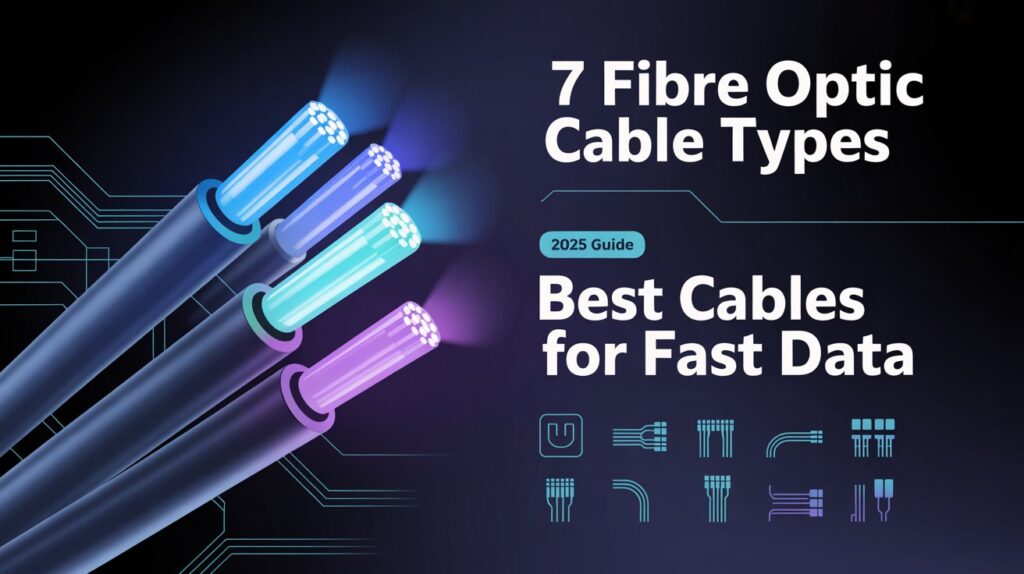As technology advances across Australia, the necessity to transmit data efficiently starts to eat up bandwidth resources. As a result, fibre optic cables have proven themselves as one of the top contenders for speed and reliability. These cables transmit data through light, providing a high-speed, reliable, and secure means of communication. The following are the seven most common types of fibre optic cables, along with a description of their features and applications in this post.
Single-mode fibre is intended for long-range transmission. It employs a tiny central core through which light propagates straight along the cable. This reduces signal loss and provides a large bandwidth. Used for long-distance data transfer, this transmission medium is widely used in telecommunications and cable television. Understanding the right fibre optic cable type ensures optimal performance for specific applications.
Multi-Mode Fibre
Multi-mode fibre is for shorter distances. It also has a thicker core with several light paths. It enjoys high data capacity but can transmit only over a short range. Multi-mode fibre is typically used for optical communication over shorter distances, such as within a building, like in local area networks (LANs), where high data transfer rates are required.
Armoured Fibre Cable
Armoured fibre cables are all-weather cables stronger than the average ones. This means that they protect the core from mechanical injuries. This feature makes them ideal for outdoor or industrial applications where cables might encounter physical stress. They are designed to transmit data that is reliable even in difficult environmental conditions; they offer such durability.
Loose Tube Fibre
Outdoor uses still commonly feature loose tube fibres. It consists of several fibres that are housed within a protective tube that is filled with a gel-like substance. It shields the strands from humidity and heat. Loose tube cables are perfect for underground or aerial installation, provide flexibility, and are resistant to environmental influences.
Tight Buffered Fibre
For indoor applications, tight-buffered fibre is used. Every fibre is buffered and can be easily handled and installed. It is not as brittle and has a compact internal design for home use. This kind is commonly utilised for network construction with space-saving as well as installation convenience.
Ribbon Fibre
Ribbon fibre cables have a high-density design. In these, multiple fibres are placed in a ribbon-like structure for easier splicing. The Australian Communications and Media Authority says that Australia’s digital economy needs high-performance telecommunications infrastructure to work. This allows them to be ideal for data centres where both space and speed are big factors. In high-density applications where space is at a premium, the small size of ribbon fibre enables maximum data transfer capability.
Simplex and Duplex Fibre
There are both simplex and duplex fibres based on transmission requirements. Simplex fibre has one type of strand in it and is best used for one-way communication. Duplex fibre is made of 2 strands; hence, it can send and receive data. These types are generally utilised in homes or small companies where basic data transmission is sufficient.
Select an Appropriate Fibre Optic Cable
Choosing the right fibre optic cable generally depends on distance, environmental factors, and what data you need to transfer. Knowing which type of cable is required is based on understanding the specific needs. In other words, single-mode fibre may be a good option for long-distance communication, whereas tight-buffered or even multi-mode fibre may be essential to indoor networks.
Advantages of Fibre Optic Cables
Advantages of fibre over copper: fibre optic provides many advantages over traditional copper cable. They have more bandwidth, which enables the transmission of greater amounts of data at the same time. Light is used instead of electricity, which minimises interference with other devices and is more secure. Furthermore, utilising fibre optic cables is lightweight and not easily influenced by weather conditions, which makes them long-lasting and dependable.
Applications Across Industries
Fibre-optic cable: fibre-optic communication uses at least one strand of glass or plastic fibre to guide waves of light. Telecoms enable broadband internet and TV. They serve a crucial function in data centres, facilitating more efficient management of data. Fibre optics supports medical imaging and telemedicine in healthcare. They also allow for uninterrupted streaming and gaming experiences even within the entertainment space.
Future Prospects
With ongoing advancements in technology, the need for higher-speed and more stable data communication will only increase. This is where fibre optic technology is set to step in and meet the demand. With the introduction of innovations and advances in fibre optics, in the future, we will see an even higher level of efficiency and accessibility, and the technology will continue to define the future of communication.
Conclusion
Fibre optic cable is the foundation of modern communication. There are many types, from single-mode to ribbon fibre, with specific advantages for the different applications of fibre optics. Understanding these types enables you to make decisions that ultimately enhance the efficiency of data relaying from one location to another. Fibre optics provides speed, reliability, and security that are still critical as our need for a strong communication infrastructure increases.

